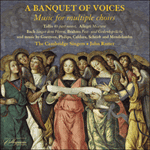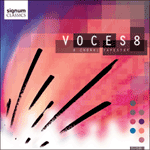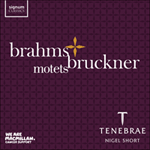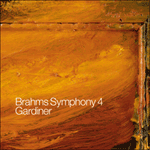
Welcome to Hyperion Records, a British classical label devoted to presenting high-quality recordings of music of all styles and from all periods from the twelfth century to the twenty-first.
Hyperion offers both CDs, and downloads in a number of formats. The site is also available in several languages.
Please use the dropdown buttons to set your preferred options, or use the checkbox to accept the defaults.

The opening of ‘Unsere Väter hofften auf dich’ (F major, 3/4) immediately establishes the antiphonal nature of all three settings, the basic musical material being announced each time by the second choir and then embellished by the first, overlapping at the distance of one bar. The concluding section (‘Der Herr wird seinem Volk’) moves into quadruple time, opening with the male voices of both choirs, and developing into a culminatory passage of free, eight-part counterpoint. ‘Wenn ein starker Gewappneter’ is structurally the simplest of the three, being cast in a clearly identifiable ABA form, whereby the Handelian opening music returns once more at the end. The C minor middle section is highly dramatic, including a biting setting of ‘ein Haus fället’. The Venetian style is at its most potent in ‘Wo ist ein so herrlich Volk’, with its imposing antiphonal terracing. The closing bars show Brahms’s inspiration running at white heat, being a poignant reminder of the opening music in the form of a series of moving suspensions held over a low, tonic pedal point.
from notes by Julian Haylock © 1991
Dès l’ouverture de «Unsere Väter hofften auf dich» (fa majeur, 3/4) la nature antiphonique de ces trois mises en musique est établie. Le matériau musical de base est annoncé chaque fois par le second chœur, puis est embelli par le premier, se chevauchant à une mesure de distance. La section finale «Der Herr wird seinem Volk» change en mesure quadruple, avec une ouverture avec les voix d’hommes des deux chœurs qui se développe en un passage de contrepoint libre à huit parties. La structure de «Wenn ein starker Gewappneter» est la plus simple des trois pièces, écrite sous une forme facile à identifier ABA, selon laquelle la musique Handelienne initiale réapparaît encore à la fin. La section centrale en ut mineur est très dramatique, et comprend une mise en musique mordante de «ein Haus fället» («une maison s’écroule»). Dans «Wo ist ein so herrlich Volk», le style vénitien se fait sentir de la manière la plus forte, avec ses imposants arrangements antiphoniques en terrasses. Les mesures finales démontrent l’inspiration incandescente de Brahms, en rappelant de façon poignante la musique d’ouverture sous la forme d’une série de suspensions tenues au-dessus d’un son de pédale bas, longuement soutenu.
extrait des notes rédigées par Julian Haylock © 1991
Français: Alain Midoux
Die Eröffnung von „Unsere Väter hofften auf dich“ (F-Dur, 3/4-Takt) etabliert sogleich den antiphonen Charakter aller drei Vertonungen, deren musikalisches Grundmaterial jedesmal durch den zweiten Chor angekündigt und dann um einen Takt versetzt vom ersten ausgeführt wird. Der letzte Abschnitt („Der Herr wird seinem Volk“) geht zum 44-Takt über. Er fängt mit den Männerstimmen beider Chöre an und entfaltet sich zu einer kumulativen Darbietung freien achtstimmigen Kontrapunkts. „Wenn ein starker Gewappneter“ ist vom Aufbau her das schlichteste der drei Stücke. Es hat eine eindeutige ABA-Form, die daran zu erkennen ist, daß die an Händel erinnernde Musik der Einleitung am Ende wiederkehrt. Der Mittelteil in c-Moll ist hochdramatisch, mit einer schneidenden Vertonung der Worte „ein Haus fället“. Der venezianische Stil macht sich am deutlichsten bemerkbar in „Wo ist ein so herrlich Volk“ mit seiner eindrucksvollen antiphonen Staffelung. Die Schlußtakte zeigen Brahms’ Inspiration in voller Blüte. Sie dienen als ergreifende Erinnerung an die Musik der Eröffnung und nehmen die Gestalt einer Serie bewegender Vorhalte über einem tiefen Orgelpunkt in der Tonika an.
aus dem Begleittext von Julian Haylock © 1991
Deutsch: Anne Steeb/Bernd Müller
 A banquet of voices A banquet of voices"Revisiting this 1993 Cambridge Singers recording, I realize I should never have withdrawn it from the Collegium catalogue—and all because of an obscure musicological question in my mind over a Gregorian chant, long since resolved. We assembled a ...» More |
 A choral tapestry A choral tapestryA Choral Tapestry' explores the rich vocal timbres of sacred vocal music spanning five centuries. Interweaving genres create an ethereal sonic tapestry that centres around the haunting beauty of William Byrd's Mass for Four Voices. The programme i ...» More |
 Brahms & Bruckner: Motets Brahms & Bruckner: MotetsAward-winning choir Tenebrae performs a sumptuous selection of motets by Johannes Brahms and Anton Bruckner. A portion of the proceeds from sales of this recording will be donated to Macmillan Cancer Support.» More |
 Brahms: Symphony No 4 & other works Brahms: Symphony No 4 & other works Classic FM Classic FM The Sunday Times» More The Sunday Times» More |

